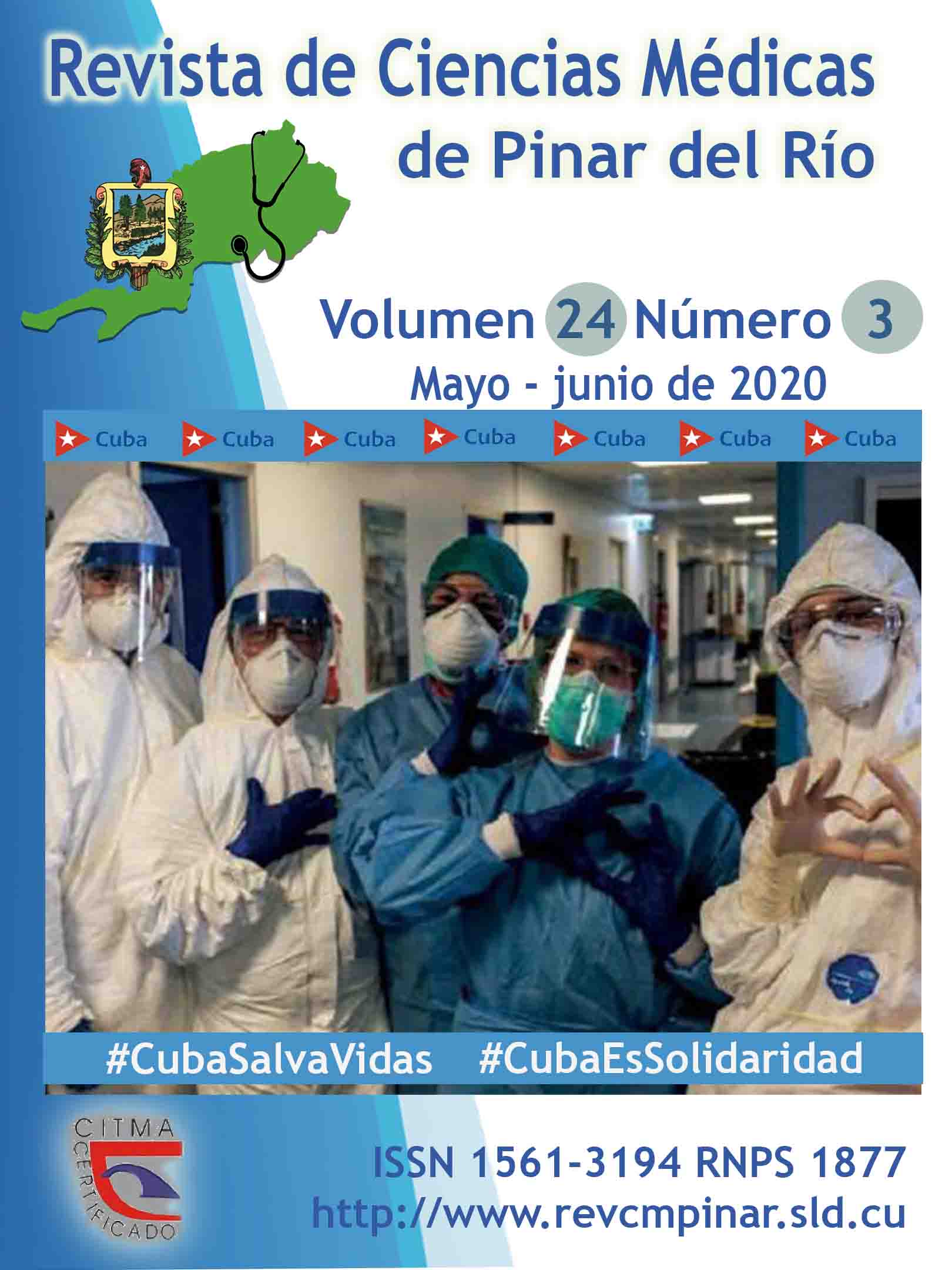Intrinsic and extrinsic risk factors on the triggering for hospital-acquired infections
Keywords:
CROSS INFECTION, INCIDENCE, ESCHERICHIA COLI, RISK FACTORS, RESPIRATORY TRACT INFECTIONSAbstract
Introduction: hospital-acquired infections stand as a significant public health problem of great economic and social impact and constitute a challenge for the health care institutions.
Objective: to determine the incidence of intrinsic and extrinsic risk factors on the triggering for hospital-acquired infections at Leon Cuervo Rubio Clinical Surgical Teaching Hospital in Pinar del Rio during 2017.
Methods: descriptive, longitudinal and prospective research in a group of patients who suffered from hospital-acquired infections (N=361). The sample comprised 357 patients presenting these infections once the exclusion criteria were applied. The controls were randomly chosen from a day-to-day list of patients admitted. The variables studied were: age, sex, and hospital stay, with site of the infection, isolated microorganisms as well as intrinsic and extrinsic risk factors.
Results: a marked prevalence after 65 years old in both sexes, the mean of patients presenting hospital-acquired infections was 7.1 days; the most frequent site of infections was in the respiratory tract (46.5 %). Escherichia Coli (35.9 %) was the most isolated microorganism. The presence of coma in the previous 48 hours of the infection, ischemic heart disease and chronic renal failure were the most representative variables of intrinsic risk on the triggering for hospital acquired-infections and the variables of extrinsic risk was associated with the presence of nasogastric tube, the stay in the Intensive Care Unit and the intubation.
Conclusions: the intrinsic and extrinsic risk factors are representative on the triggering for hospital acquired-infections. Prevention and control are required to decrease its incidence.
Downloads
References
1. Arango Díaz A, López Berrío S, Vera Núñez D, Castellanos Sánchez E, Rodríguez Sanabria PH, Rodríguez Feitó MB. Epidemiología de las infecciones asociadas a la asistencia sanitaria. Acta Médica del Centro [Internet]. 2018 [citado 18/12/2018]; 12(3): [aprox. 10 p.]. Disponible en: http://www.revactamedicacentro.sld.cu/index.php/amc/article/view/923
2. Protocolo de vigilancia y control de las infecciones relacionadas con la asistencia sanitaria en unidades de cuidados intensivos. Elaborado por el Grupo de Trabajo de Vigilancia de las IRAS [Internet]. Madrid; 2016 noviembre [Citado: 11/06/2018]. Disponible en: https://www.isciii.es/QueHacemos/Servicios/VigilanciaSaludPublicaRENAVE/EnfermedadesTransmisibles/Documents/PROTOCOLOS/
3. Fiterre Lancis I, Sabournín Castelnau NL, Bandera Sánchez O, Sarduy Chapis RL, Castillo Rodríguez B, Fernández Salazar VS. Infecciones asociadas a la Asistencia Sanitaria en un Hospital especializado en el paciente nefro-urológico. Rev haban cienc méd [Internet]. 2017 Jun [citado 23/02/2020]; 16(3): 479-488. Disponible en: http://scielo.sld.cu/scielo.php?script=sci_arttext&pid=S1729-519X2017000300017&lng=es
4. Organización Mundial de la Salud. Carga mundial de infecciones asociadas a la atención sanitaria [Internet]. 2018 [citado 20/02/2019]. Ginebra, Suiza: OMS. [aprox. 3 pantallas]. Disponible en: https://www.who.int/gpsc/country_work/burden_hcai/es/
5. Cuba. Centro Nacional de Información de Ciencias Médicas. Biblioteca Médica Nacional. Infecciones en Hospitales. Bibliomed Suplemento [Internet]. 2018 May-Jun [citado 20/02/2019]: [aprox. 11 p.]. Disponible en: http://files.sld.cu/bmn/files/2018/05/bibliomed-suplemento-mayo-2018.pdf
6. Gordon Zamora1 E J, Masaquiza Moyolema D A, Gallegos Moreno F A, Mayorga Gutiérrez E R. La infección nosocomial. Un reto en las unidades de cuidados intensivos .Rev Enfermería Investiga, Investigación, Vinculación, Docencia y Gestión [Internet] 2018[citado 02/02/2019]; 3(Sup 1): [aprox. 10 p.]. Disponible en: https://scholar.google.com/scholar?hl=es&as_sdt=0%2C5&q=DOI%3A+10.29033%2Fei.v3sup1.2018.05+&btnG=
7. Zaragoza R, Ramírez P, López-Pueyo MJ. Infección nosocomial en las unidades de cuidados intensivos. Enferm Infecc Microbiol Clin. [Internet] 2014 octubre 23[Citado 11/06/2018]; 32(5): [aprox 7p.] .Disponible en: https://www.seimc.org/contenidos/documentoscientificos/eimc/seimc_eimc_v32n05p320a327.pdf
8. Díaz Valiente O, Rodríguez Prieto JC, Hernández Suárez N, Sandrino Sánchez M, Alfonso García I. Factores de riesgo, parámetros clínicos de infecciones asociadas a la asistencia sanitaria en un hospital. Rev Ciencias Médicas [Internet] 2017 mar -abril [Citado: 11/06/2018]; 21(2). Disponible en:
http://scielo.sld.cu/scielo.php?script=sci_arttext&pid=S1561-31942017000200007
9. Maguiña Vargas C. Infecciones nosocomiales. Acta méd. Perú [Internet] 2016 jul [Citado: 11/06/2018]; 33(3): [aprox 2p].Disponible en: http://www.scielo.org.pe/scielo.php?script=sci_arttext&pid=S1728-59172016000300001
10. Maguiña Vargas C. Infecciones nosocomiales. Acta méd. Peru [Internet]. 2016 Jul [citado 05/03/2020]; 33(3): 175-177. Disponible en: http://www.scielo.org.pe/scielo.php?script=sci_arttext&pid=S1728-59172016000300001&lng=es.
11. Pacheco Licor VM, De La C Gutiérrez Castañeda D, Serradet Gómez M. Vigilancia epidemiológica de infecciones asociadas a la asistencia sanitaria. Rev Ciencias Médicas [Internet]. 2014 Jun [citado 16/03/2018]; 18(3) [aprox. 10p]. Disponible en: http://scielo.sld.cu/scielo.php?script=sci_arttext&pid=S1561-31942014000300007&lng=es
12. Castañeda-Martínez F C, Valdespino-Padilla M G. Prevalencia de infecciones nosocomiales en un hospital de segundo nivel de atención en México. Rev Med Inst Mex Seguro Soc [Internet] 2015[Citado 18/06/2018]; 53(6): [aprox 4p.].Disponible en: http://revistamedica.imss.gob.mx/editorial/index.php/revista_medica/article/viewFile/98/235
Downloads
Published
How to Cite
Issue
Section
License
Authors who have publications with this journal agree to the following terms: Authors will retain their copyrights and grant the journal the right of first publication of their work, which will be publication of their work, which will be simultaneously subject to the Creative Commons Attribution License (CC-BY-NC 4.0) that allows third parties to share the work as long as its author and first publication in this journal are indicated.
Authors may adopt other non-exclusive license agreements for distribution of the published version of the work (e.g.: deposit it in an institutional telematic archive or publish it in a volume). Likewise, and according to the recommendations of the Medical Sciences Editorial (ECIMED), authors must declare in each article their contribution according to the CRediT taxonomy (contributor roles). This taxonomy includes 14 roles, which can be used to represent the tasks typically performed by contributors in scientific academic production. It should be consulted in monograph) whenever initial publication in this journal is indicated. Authors are allowed and encouraged to disseminate their work through the Internet (e.g., in institutional telematic archives or on their web page) before and during the submission process, which may produce interesting exchanges and increase citations of the published work. (See The effect of open access). https://casrai.org/credit/



